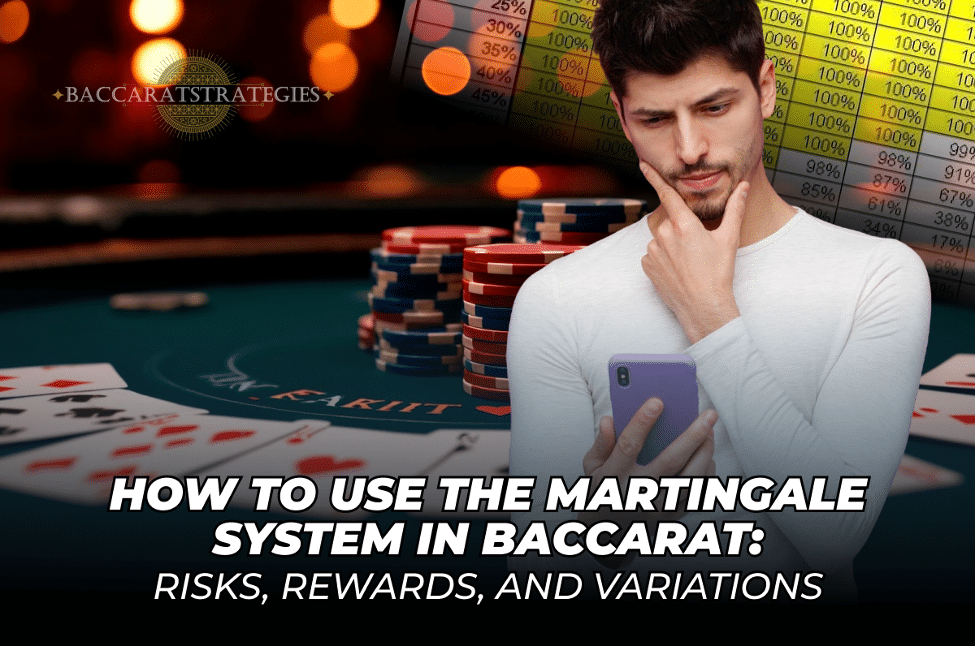Baccarat is one of the most gambling yet simple card games in casinos and you can learn more about it at baccaratstrategies.net. Many players try to apply different strategies to increase their chances of winning, and one of the most popular is the Martingale system.
Using the Martingale System in Baccarat
Martingale is a progressive betting strategy that has historically been used in roulette, but is also applicable to baccarat. The basic principle of this system is to consistently increase the size of the bet after each losing outcome in order to compensate for previous losses and get a fixed profit at the first win.
A player starts with a minimum base bet on one of three possible events: a win for the ‘Player’, a win for the ‘Banker’ or a draw. However, it should be borne in mind that the bet on a draw has an extremely high odds of casino advantage, so its use within the framework of this strategy is not recommended.
After each lost round, the amount of the next bet is doubled. This process continues until the bet is winning. In the case of a win, the player not only returns all previous losses, but also receives a profit equal to the size of the original bet.
Features of Application Martingale in Baccarat
Unlike roulette, where payments on the main bets are made at a ratio of 1:1, there are nuances in baccarat. Betting on the ‘Banker’ brings a payout of 0.95:1 due to the standard casino commission, while betting on the ‘Player’ pays out at the classic 1:1 ratio. This means that when using Martingale on ‘Banker’ the final profit after a series of losses will be slightly less than when betting on ‘Player’.
The main advantage of the strategy is its conceptual simplicity. The player does not need to make complex mathematical calculations or analyse previous results – it is enough to strictly follow the principle of doubling after a loss.
Another positive aspect can be considered the possibility of quick recovery of lost funds. Under favourable circumstances, one winning bet can compensate for a whole series of previous failures, while providing a guaranteed profit in the amount of the original bet.
In addition, the system demonstrates relative efficiency in the short term. With a sufficient bankroll and in the absence of extremely long losing streaks, a player can indeed make a stable profit on a limited number of games.

Significant Risks and Limitations of the Strategy
Despite its apparent attractiveness, the Martingale system has a number of fundamental flaws that can potentially lead to catastrophic financial consequences.
The most critical risk is the exponential growth of the bet size during long losing streaks. Each next doubling significantly increases the financial burden on the player, and the probability of a long series of consecutive losses, although small, is not equal to zero.
A serious limiting factor is the betting limits set by the casino. Even with a significant bankroll player may face a situation where further increase in the bet becomes impossible due to the maximum limit set by the administration.
It is important to consider the psychological aspect. The necessity to make bets, many times higher than the initial ones, creates strong emotional pressure, which can lead to rash decisions and violation of discipline.
Modifications of the Classic Martingale System
Recognising the extreme riskiness of the classic Martingale system, experienced players have developed several adapted versions of this strategy. These modifications retain the basic principles of progressive betting, but introduce important restrictions and new approaches to bankroll management. Let’s consider the most popular variations:
- Soft Martingale – a limited version with setting a maximum number of doubles (usually 3-5 levels). Once the limit is reached, the series stops regardless of the result. Allows you to avoid catastrophic losses, but reduces the probability of full wagering for long losing streaks.
- Reverse Martingale is a progressive strategy where bets are increased after wins rather than losses. After failure, the player returns to the initial bet. It allows to consolidate profits in successful periods without subjecting the bankroll to extreme stress.
- Fibonacci Martingale: the size of bets is determined by Fibonacci numbers (1, 1, 2, 3, 5, 8…). After winning – roll back two steps back in the sequence. Provides a smooth growth of bets with a mathematically sound progression, but requires strict adherence to the scheme.
Each of these modifications offers a different balance between the potential profit and the level of risk, allowing players to choose the option that suits their bankroll and psychological stability.
Whether to Use Martingale in Baccarat
When deciding whether to use this strategy, a player should make a sober assessment of several key factors.
The system can be effective if you have a significant bankroll, allowing you to withstand long losing streaks. It is also important to choose a gaming table with high enough betting limits to avoid the situation when further increases in bets becomes impossible.
However, it must be realised that no single strategy can overcome the casino’s advantage in the long term. Even the most sophisticated betting management system does not change the mathematical expectation of the game, but only redistributes the probability of profit and the size of potential losses.
To minimise risks, it is recommended to combine elements of Martingale with other strategies, for example, to bet exclusively on the ‘Banker’ (as an option with the smallest casino advantage) and set strict limits on the maximum bet size and the allowed number of doubles.
